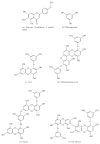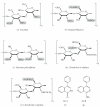Anticancer drugs from marine flora: an overview
- PMID: 21461373
- PMCID: PMC3065217
- DOI: 10.1155/2010/214186
Anticancer drugs from marine flora: an overview
Abstract
Marine floras, such as bacteria, actinobacteria, cyanobacteria, fungi, microalgae, seaweeds, mangroves, and other halophytes are extremely important oceanic resources, constituting over 90% of the oceanic biomass. They are taxonomically diverse, largely productive, biologically active, and chemically unique offering a great scope for discovery of new anticancer drugs. The marine floras are rich in medicinally potent chemicals predominantly belonging to polyphenols and sulphated polysaccharides. The chemicals have displayed an array of pharmacological properties especially antioxidant, immunostimulatory, and antitumour activities. The phytochemicals possibly activate macrophages, induce apoptosis, and prevent oxidative damage of DNA, thereby controlling carcinogenesis. In spite of vast resources enriched with chemicals, the marine floras are largely unexplored for anticancer lead compounds. Hence, this paper reviews the works so far conducted on this aspect with a view to provide a baseline information for promoting the marine flora-based anticancer research in the present context of increasing cancer incidence, deprived of the cheaper, safer, and potent medicines to challenge the dreadful human disease.
Figures
References
-
- Gurib-Fakim A. Medicinal plants: traditions of yesterday and drugs of tomorrow. Molecular Aspects of Medicine. 2006;27(1):1–93. - PubMed
-
- Halliwell B. Dietary polyphenols: good, bad, or indifferent for your health? Cardiovascular Research. 2007;73(2):341–347. - PubMed
-
- Rios ADO, Antunes LMG, Bianchi MDLP. Bixin and lycopene modulation of free radical generation induced by cisplatin-DNA interaction. Food Chemistry. 2009;113(4):1113–1118.
-
- Langseth L. Oxidants, Antioxidants, and Disease Prevention. Washington, DC, USA: International Life Sciences Institute Press; 1995.
-
- Kikuzaki H, Usuguchi J, Nakatani N. Constituents of Zingiberaceae. I. Diarylheptanoids from the rhizomes of ginger (Zingiber officinale roscoe) Chemical and Pharmaceutical Bulletin. 1991;39(1):120–122.
LinkOut - more resources
Full Text Sources





